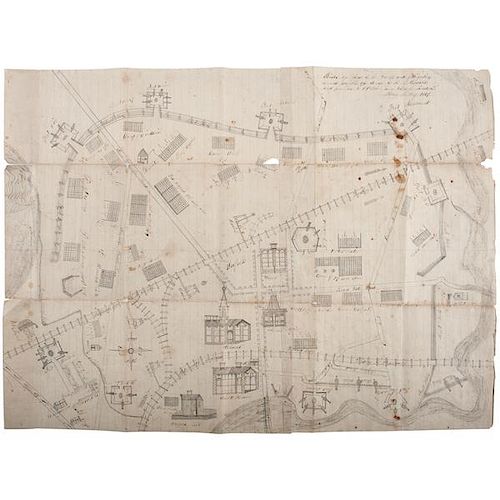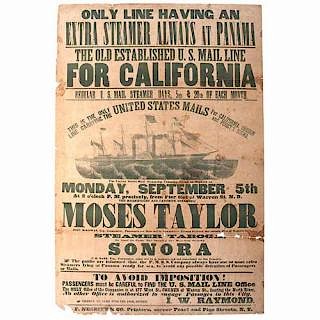Civil War Hand-Drawn Map, Bird's-Eye View of the Camps and Fortifications Around Suffolk, Virginia, May 12th, 1863
About Seller
6270 Este Ave.
Cincinnati , OH 45232
United States
With offices in Cincinnati, Cleveland and Denver, Cowan’s holds over 40 auctions each year, with annual sales exceeding $16M. We reach buyers around the globe, and take pride in our reputation for integrity, customer service and great results. A full-service house, Cowan’s Auctions specializes in Am...Read more
Two ways to bid:
- Leave a max absentee bid and the platform will bid on your behalf up to your maximum bid during the live auction.
- Bid live during the auction and your bids will be submitted real-time to the auctioneer.
Bid Increments
| Price | Bid Increment |
|---|---|
| $0 | $25 |
| $500 | $50 |
| $1,000 | $100 |
| $2,000 | $250 |
| $5,000 | $500 |
| $10,000 | $1,000 |
| $20,000 | $2,500 |
| $50,000 | $5,000 |
| $100,000 | $10,000 |
About Auction
Jun 10, 2016 - Jun 11, 2016
Cowan's Auctions dawnie@cowans.com
- Lot Description
Civil War Hand-Drawn Map, Bird's-Eye View of the Camps and Fortifications Around Suffolk, Virginia, May 12th, 1863
Hand-drawn map, mostly in pencil, with labels in iron gall ink, 15.5 x 21 in. Captioned upper right: Birds eye view of the Camps and fortifications around Suffolk, Va. drawn by Henry Oswald and presented to Wm. Price as a token of friendship. / May the 12th 1863. We find both a Henry Oswald and William Price serving in the 33rd New York Infantry.
Henry Oswald enlisted on May 22, 1861 at Buffalo and William Price at Palmyra the same day, both for two years as privates in the 33rd New York Infantry. They were a bit older than the usual recruit, being 25- and 27-years-old, respectively. Price was mustered out just a year after the unit was accepted into Federal service for unstated reasons. (Since he was released in Virginia, disease is the first suspect. Northern soldiers did not fare well in southern summers.) Oswald finished his two years of service, then enlisted in the NY 24th Cavalry.
The map details the large features of Suffolk, very artistically rendered. The forts, complete with cannons, are: Fort Dix; Fort Union; Fort McCllen [sic]; Fort Nansemond; Fort Peck; Fort Rosecrans; Fort Jerico [sic]; Fort Halleck; Fort Dodge; Fort Seward; Fort Terry; South Quay Batry [sic].
The railroads suggest the immediate importance of Suffolk: Oswald has drawn the “Railroad from N[or]folk to Suffolk” (then further down the line) “leading to Richmond” and “Portsmouth Railroad” (then further down the line) “leading to Petersburg.” One side of the town was “protected” by the Dismal Swamp, included on the left side of the map. Flowing along the right side and about half way across the bottom is the Nansemond River.
He has also rendered many roads and buildings: various breast works and batteries; grist mill; Cavalry Road; Artillery Road; Norfolk Public Road; Scouting Road; Break Water Road; Signal Station; Sutler’s GES; Cap Sullivens GES; Depot; Church; Court House; Water Tank, and many more small structures.
The unit camps he identified were: 69th NY; 13th Indiana; 11th PA Cav.; 112th NY; 161 PA militia; 165 PA M[ilitia?]; 166 PA M; 6th Mass.; Sharpshooters; 155th NY; 169th NY; 31st NY; 3rd Brigade 9th Army “Chore” (Corps); 9th Army Corps; Howard’s Batry [sic]; 1 PA Batry; 10th NH; 7th Mass. Batry; and
mounted riflemen.
What is not clear is what Oswald was doing in Suffolk. The city was under siege from April 11 to May 4, 1863 by Longstreet’s forces. Longstreet was given several tasks by Lee, including protecting Richmond, dislodging the Federals from Suffolk (which obviously had direct lines to Richmond and Petersburg), foraging the countryside for supplies, as well as supporting Lee’s forces when needed. Occurring between the battles of Chancellorsville and Marye’s Heights (Second Fredericksburg), this engagement has been all but forgotten.
The 33rd New York was engaged at Chancellorsville from April 30 to May 2. It then moved to Marye’s Heights on May 3, where it lost over 200 men. The unit returned to their winter camp of the previous season at White Oak Church (Falmouth, VA) on May 14, but what it was doing between May 4 and May 14 is not clear. Falmouth is just across the Rappahannock River from Fredericksburg, near where their last engagement was.
Apparently they traveled to Suffolk, however. When looking at the town’s fortifications, one can well imagine these soldiers coming out of the field into this armed camp and writing home to their friends “You ought to see this place…” One of those stories, probably apocryphal, to come out of the war was the quip by one soldier who was involved in building the defenses of Suffolk that he hoped Major General Peck died two weeks before him, because then Peck would have Hell so well-fortified that no one else would be able to get in. Oswald may have traveled there to a Federal hospital. There were a number of other New York units at Suffolk. He is listed as wounded at Antietam, then at Cold Harbor as a member of the 24th Cavalry. He was absent at muster out on June 2, 1863 and some sources suggest he was possibly hospitalized again. (This may also account for the 8 months between leaving one unit and joining the other – he was still healing.) If not treated at Suffolk, it was certainly a transportation hub to get him to Washington or even back to New York.
Although Price survived the war, never suffering an injury, the consignor, a descendant of Price, relates history passed down through the family, which indicates that he returned home and worked for the railroad as a carpenter. He was helping to build a railroad bridge across the Susquehanna river, "tripped," and fell into the river and drowned.
A wonderfully drafted map packed with information.Folded, with many separations along folds. A few small holes at intersections of folds, impacting just a few words (such as "Norfolk" along the railroad). A few scattered brown spots, with one small cluster in the upper right area. Overall still good.Condition
- Shipping Info
-
SHIPPING. At the request of the buyer, Cowan's will authorize the shipment of purchased items. Shipments usually occur within two weeks after payment has been received. Shipment is generally made via UPS Ground service. Unless buyer gives special instructions, the shipping method shall be at the sole discretion of Cowan's Auctions, Inc.. Cowan's is in no way responsible for the acts or omissions of independent handlers, packers or shippers of purchased items or for any loss, damage or delay from the packing or shipping of any property.
-
- Buyer's Premium



 EUR
EUR CAD
CAD AUD
AUD GBP
GBP MXN
MXN HKD
HKD CNY
CNY MYR
MYR SEK
SEK SGD
SGD CHF
CHF THB
THB











